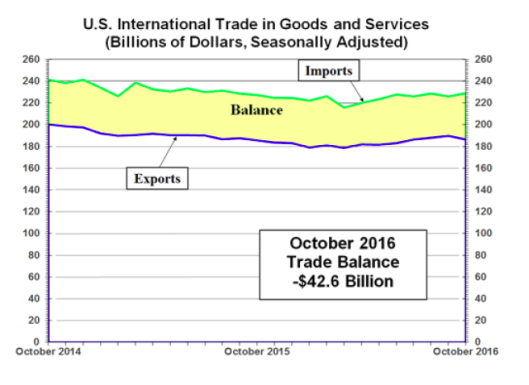The Census Bureau report on International Trade shows a widening trade deficit.
Exports decline 1.8%. Imports rise 1.3%.

The U.S. Census Bureau and the U.S. Bureau of Economic Analysis, through the Department of Commerce, announced today that the goods and services deficit was $42.6 billion in October, up $6.4 billion from $36.2 billion in September, revised. October exports were $186.4 billion, $3.4 billion less than September exports. October imports were $229.0 billion, $3.0 billion more than September imports.
The October increase in the goods and services deficit reflected an increase in the goods deficit of $6.3 billion to $63.4 billion and a decrease in the services surplus of $0.1 billion to $20.8 billion.
Year-to-date, the goods and services deficit decreased $8.8 billion, or 2.1 percent, from the same period in 2015. Exports decreased $58.7 billion or 3.1 percent. Imports decreased $67.5 billion or 2.9 percent.
How Will This Affect GDP Estimates?
The answer is “not at all”. That may seem surprising because imports subtract from GDP while exports add.
The reason this will not affect estimates much is the report was in-line with the advance report and the numbers were pretty much known.
Economist Panel Almost Gets Number Right
The panel of Bloomberg Econoday economists got the number almost correct.
The Econoday consensus estimate was a deficit of $42.0 billion vs. an actual deficit of $42.6 billion.
The moral of this story is that if you tell a group of economists the correct number in advance, the consensus may come close. That said, at least one economist was way off, estimating a deficit of only $39.0 billion.
I suspect he or she was not in class they day they passed out the the answers to the upcoming test.
Two Piece Puzzle
I presented the advance report on November 25 in Trade Deficit Widens 9.6% as Exports Dip, Food Exports Decline 11.8%.
That report shows a deficit of $62.0 billion, but that number just reflects “goods”. Today’s report covered goods and services.Those studying the pre-test material only got the biggest piece of the two-piece puzzle, not the entire puzzle.












Leave A Comment